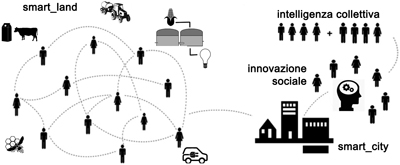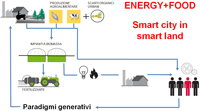You are in: Home page > Magazine Archive > food & energy-scape

Barbara Melis, Graziella Roccella
food & energy-scape
Efficient Management of Resources in the Smart-City: New Themes for Urban Design

Scheme of closed loop processes: food – energy – social innovation (authors elaboration).
Abstract
In the smart city era, eating and producing energy for one’s own needs are intrinsic aspects of housing that, the city has to face in a systemic way in relation to the resources of its territory for the economic, environmental and social wellness of its community. The revival of the importance of short supply chains, both in the agrifood and in the pure energy fields, calls into play the internal balance of the built landscape and redefines the hierarchies in the organization of the production platform, stimulating a reflection on renewed themes of design in the urban metropolitan scope.
Text
The role of urban design in the transition from city to smart city is to set up suitable places in order to use efficiently local resources. In this process (with the perspective of environmental sustainability), smart technologies will be used such as tools to coordinate and manage complex issues. Food and Energy are two of these themes, that cities must welcome and design a place for.
Last decades saw urban design dealing with the theme of environmental sustainability. From the beginning of Nineties, Architecture too was engaged to answer to worldwide transdisciplinary request of coping to the diffused environmental degradation. In specific some attentions were requested: soil preservation, waste reduction, pollution prevention, transportation and energy management, natural elements management and their protection.
After this season of studies, from official documents (i.e. EU Directives, Guidelines) and from pilot projects, it is possible to identify some design criteria to work on: compactness, functional mix, design with natural elements (water and green), use of bioclimatic technology (for an efficient use of local resource) and mobility. These issues are not new themes if we consider them singly but if we are working with environmental sustainability aim, with a systemic approach and a simultaneous vision (Bonomi, Masiero, 2014), they look like new subjects for smart city challenge.
Certainly today the commitment towards sustainability has not ceased; rather, recently, it has joined the topic of smart city. In this new situation, smartness should be able to improve city life, primarily through the application of digital technologies. If the smart attitude, is reduced and trivialized such as the implementation of digital technologies in urban design or in buildings, it doesn’t succeed in returning the complexity of environmental, economic and social issues. The management of this complexity, instead, defines a new sense for contemporary urban housing. Smart + City is a couple that expresses a cultural leap towards a smart community in which technical innovation accompanies a social model not yet rigid and vertical, but flexible and characterised through horizontal relationships1 .
So today’s challenge is to give an answer to sustainability issues through urban design project, by using smart technologies to connect all city activities in a unique diagram of operation.
In the debate on the smart city, two positions seem to occur: on one hand projects of new energy production which use resources in a systemic way and on the other places of collection and distribution of food production of high quality and short chain2. Given the general interest, the paper proposes a reflection on the use of food and energy factor to enter the mechanism of production of the territory and redirect actions in a smart way. In particular, making a system with the actors of the food and energy network would be a first step to build synergies to serve as a garrison of the territory and may increase its enhancement.
We report here the synthesis of a reflection pertaining to a possible theme of innovative project dedicated to the areas of production and exchange of energy and food in protected areas around Turin (Melis, Roccella, 2014). These are activities that take up space and can be adjusted according to autonomous flows but, in a smart city, they can even match and contribute to the design of a new generative script that reconnects a city to its land that sustains and feeds it.
In accordance with the principle of the disappearance of the model of pure molecular capitalism in Italy (Bonomi, 2014) we see that even in Piedmont, in the areas of excellent agrifood production, the settlement pattern that resulted from this economic approach, based on sprawl, entered in crisis when the creative density of territory has given way to the changes put in place by the sudden arrival of external capital flows that modify the territorial assets. It is the case of major hypermarket chains that, contending for the primacy of the most accessible location, have effectively consumed precious periurban areas, thus extending the margin of the city rather than helping to reshape it, as instead it would be happened by reusing abandoned industrial structures. This is what happened in Turin metropolitan area, in recent times, even in areas adjacent to protected areas, at the expense of pre-existing agribusiness, thus compromising the precious but fragile balance between the built and rural areas. At the same time, the emergence of new power plants from biomass is a pretext to rediscuss the networking of resources, capitals and the collective creativity, towards new forms of green economy and new territorial structures.
The energy theme has always been shaping urban and land transformations; we can think about big hydroelectric plants built between XVIII and XIX centuries, or to the coming of electric grids and consequent urban sprawl, or even to energy symbols scattered in urban landscape (Ciorra, 2013). In all this situations artefacts are a medium which talks about society and energy relationship.
In the Fifties, the social interest in the energy theme decreased, and so did architectural attention in energy plant building, because energy became an obvious element in city life.
But afterward we have assisted to a reversal of the trend, caused by the advent of environmental sustainability, as aforementioned.
Instead, this reconsideration hasn't replayed the past construction methods for plants, because new supplying sources (renewable energies) and new management systems of energy production and distribution (smart grid, energy district system) (Cumo, 2011) have lead to disrupt at least three collective imaginations: big dimension, accessibility with regard to the past impassability of plants gates and borders and finally the localisation, often indifferent to the specificity of landscape.
In fact new conception small energy plants are often buildings a few hundreds of cubic meters large, commonly have only one or two floors, and are inserted in urban space without fences. Their dimensions make them suitable for local renewable energy sources, such as small amounts of biomass, fact that underlines the specificity of the Regions. Lastly they are often integrated into mixed uses spaces, sometimes used for leisure or educational activities by citizens (Melis, Mutani, 2013).
These new spaces for energy supply accord well with the latest trends in food management that foster the local dimension, tend to shorten the distribution chain and strive to reduce waste. In this perspective the matching energy / food makes the closure of matter cycles possible through the energy exploitation of the organic waste, besides to sharing spaces, with a consequent reduction of soil consumption.
Alongside tools of energy governance and besides the flourish of food planning policies, recently investigated by the urban planning Italian scene, urban design can come back to deal with the design of the edge of the smart city and has to deal with the new logic of matching between demand and offer in the energy and agribusiness fields, involving the construction of exchange hubs, accessible to the public. The case of the protected areas of the metropolitan area of Turin, such as La Mandria Park (Barzan, Grella, Roccella, 2013), shows that interventions in these areas provided with a consolidated agricultural vocation, would have an important impact on a large number of subjects. This network of stakeholders could spread the identity values of food&energy-scape by preventing further use of land, in addition to meeting local needs.
In those that we could described as ENERGY & FOOD HUBS, the production and exchange of two key elements for the development of the social life in the smart city, would help to transit the vitality of the production platform of geo-communities - made not only of farms but also of agribusiness - in the operation of redesign of the urban spaces in the fields of the production, processing and distribution of energy and food. It comes to conceive new centers of production and exchange of food and energy, where the manufacturers confer their products, whose wastes are used for energy production and where the citizen can go and purchase and simultaneously monitor in real time sustainable use of resources and even attend energy education projects.
The ENERGY+FOOD hub is configured as a new open, multifunctional place, adaptable to the specific user, connected to the flow of information and self-adjusting, a design model that generates new ways to enjoy landscape instead of consuming it and encourages variety of form, which produces social inclusion and is able to put in dialogue the production platform of the territorial district with the requirements of the metropolitan city, combining smart city and smart land.
Notes
1 For the matter of social innovation look at Murray, Caulier-Grice, Mulgan, 2010.
2 E.g.: Soon-In Yang, Energy FARMacy, project exposed at Energy Exhibistion, MAXXI 2013; Rural Hub, incubator of new models of economic development for rural business, Napoli, www.ruralhub.it; Officine Corsare, FHTC (Food Hub TO Connect), winning project of the call by MIUR Smart Cities and Communities and Social Innovation, 2012
Reference
Barzan, F., Grella, S., Roccella, G. (2013). Abitare nei paesaggi d’eccellenza: Smart-food e turismo verde intorno al Parco La Mandria. Convegno Nazionale Aiapp, “Paesaggio come motore di sviluppo economico”. Sede: Roma. Data: dicembre 2013
Bonomi, A., Masiero, R. (2014). Dalla smart city alla smart land. Venezia: Marsilio
Caulier Grice, J., Murray, R., Mulgan, G. (2010). The Open Book of Social Innovation. So-cie-ting, Young Foundation
Ciorra, P (a cura di) (2013). Architettura e reti del petrolio e del post-petrolio. Milano: Electa; Roma: MAXXI
Cumo, F. (editor) (2011). SoURCE. Sustainable urban cells. Energy and environment: sus-taina-ble citie. Roma: Quintily spa
Melis, B., Roccella, G. (2014). Smart Food and Energy. Valorizzare il paesaggio peri-urbano con cicli produttivi chiusi. Urbanistica Informazioni (257), 113-116,
Melis, B., Mutani, G., Social energy e produzione distribuita in ambiente urbano: nuova vo-ca-zione e nuovo business per gli spazi pubblici. Il caso della piccola centrale idroelettrica Miche-lotti del Comune di Torino. “Smart City Exhibition”. Sede: Bologna. Data: ottobre 2013
Quintelli, C. (a cura di) (2011). Cosa intendiamo per Food Valley?. First Parma Food Valley Symposium. Parma: Festival Architettura Edizioni
Barbara Melis, Postdoctoral Research at DAD - Politecnico in Turin, is Lecturer in “Architectural Tech-nology”. Since 2010 she has been researching in the environmental integration of small energy plants for renewable energy source. The study reflects on the role of distributed energy infrastructures and the challenge of making an urban paradigm that can offer real and convincing architectural answers about the rational use of energy. She collaborates with energy companies and Public Administrations. From 2006 to 2009 she was a member of “Architecture and sustainable city” commission of Chamber of Architects of Turin. Since 2008 she is a member of Institute of Mountain Architecture (IAM).
Graziella Roccella, Postdoctoral Researcher at DAD - Politecnico di Torino is Adjunct Professor in Urban and Architectural Design. She researches in the field of Housing in the Lands of Excellence with reference to the urban-rural transition fringes in the Metropolitan City of Turin, in particular near parks. She is Head of Druento Landscape Commission and has recently started up the project for coordinating the commissions of 14 municipalities members of La Mandria Park Community in order to define guidelines for intervention on the buildings involved in the systemic management of food resources of the area.














